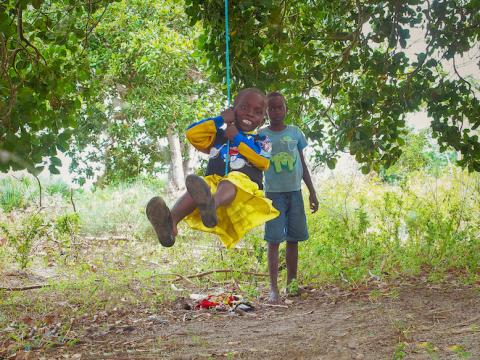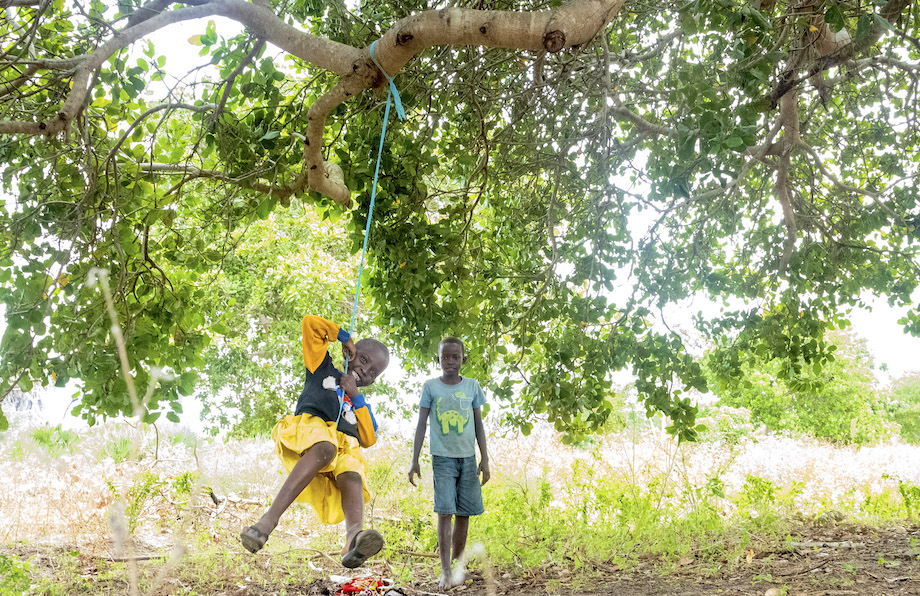Communities tackle climate change and improve their livelihoods by conserving forests

By Martin Muluka, Emergency Communications Specialist, World Vision Kenya
A huge cashew nut tree with broad leafy branches is a favourite play area for six-year-old Mary and her brother. The tree, which was once part of a forest, has been in their home compound for years.
A simple swing, made of a rope hanging on a branch, provides them with so much joy and relaxation away from the scorching sun.
Their ringing laughter fills the air, rhyming with a cool breeze generated from the forward and backward movement of the swing. Sadly, this is one of the few remaining trees at her home, in Kipini village, situated in the vast arid and semi-arid Tana River County, Kenya.

Mary prays and hopes that this tree will be able to survive the rampant deforestation happening in the area, due to increased demand for charcoal.
“I like this tree because this is where we play with my friends. When we get tired, we sit down and watch birds play in the branches. There was another tree, which we liked too, but it was cut down and used for firewood. When it fell, we were all sad. It came down with bird nests filled with eggs and chicks. I know that this made the mother birds sad and it made me cry,” she says.
At her young age, Mary is already aware of the benefits of trees and has been encouraging her parents to conserve the remaining trees on their land, while growing more to replace those cut in the past.
“Our teacher says that if we cut trees, there will be no places for children to play in because the shade protects us from the hot sun which we have here. He also said that without trees, there will be no rain which my parents need for growing food that we eat. Without rain, there will also be no grass for our cows to eat so that they can give us milk,” she says.

Mary is among the many children and families that have been disproportionately affected by the adverse effects of climate change such as prolonged droughts, hunger and water shortage in Kenya. These challenges have been accelerated as tree cover rapidly diminishes in her community.
“I have lived in Kipini for many years. We moved here –to flee the drought and conflicts arising from competition for inadequate pasture in the drier parts of Tana River. But it seems that those problems have followed me here too. When we first arrived in this village, life was good. There was adequate rainfall and we had fertile land covered with beautiful canopies. But as more people settled here, they cut down trees and since then, things have never been the same. The rain patterns are now irregular and this has affected our farming,” says Dorcas who is concerned about the effects of these challenges on Mary and her other children.
To address this problem, World Vision through its Tana River Climate Change and Livelihoods Restoration Project (TCLIRP) - funded by the organisation’s donors in Korea - is empowering communities to adapt and mitigate the negative impact of climate change.
The project is being implemented in collaboration with partners like; the Kenya Forest Service, the National Environmental Management Authority (NEMA), Kenya Flying Labs, Global System for Mobile Communications (GSMA) and Ushahidi.
A key component of the project focuses on awareness creation on the importance of trees and the significant role that they play in climate change mitigation. This is done in partnership with community-based organisations.
In addition, the project is supporting communities to increase tree cover on their land through the Farmer Managed Natural Regeneration (FMNR) approach that is championed by World Vision.
This technique enables communities to boost the growth of indigenous tree species through effective pruning methods, as well as the use of existing tree stumps and naturally occurring tree seeds found in different soils.
Most of the land left bare in the Tana River County, due to massive deforestation, was later colonised by an invasive species (Prosopis Juliflora) that is locally known as Mathenge.
“This Mathenge shrub cannot allow anything to grow here. As a result, families cannot farm on this land neither can they graze their animals since the invasive plants inhibit the growth of food crops and pasture,” says Collins, an Environmental Conservation Specialist who heads World Vision’s TCLIRP initiative in Tana River County.
To mitigate this challenge, he notes that the project is supporting communities to clear the Mathenge shrub from their land and reseed or plant indigenous trees and grass which are beneficial for their livelihoods.
Since the area affected by the shrubs is vast, World Vision and its implementing partners have embraced drones as a technological solution to accelerate the mapping of worst affected areas in dire need of assisted natural regeneration.
Those drones are also being used in the aerial dispersion of seed balls. These are seeds of indigenous trees that have been wrapped in a mixture of soil and compost, then dried to protect them from being eaten by birds and animals.
“Our plan is to rapidly fill up the affected areas with indigenous trees and grass that are well adapted to the climatic conditions of Tana River County. They are helping to restore over 2,500 acres of degraded lands - previously filled with the Mathenge shrub, so they can regain their productivity,” notes Collins.

Already, communities are beginning to reap benefits from the grass that they planted using seeds distributed through the TCLIRP initiative.
“Planting this grass is one of the best things I have done. I benefitted from training on land restoration, where we were taught how to clear the invasive Mathenge shrub from our land and thereafter given grass seeds to plant. The grazing land for my goats had been reducing over the years but now I have enough pasture, thanks to the grass. I am happy that I can now get enough milk and meat for my children,” says Nuru, one of the many people that the TCLIRP project has benefitted in Tana River County.

In collaboration with the Kenya Forest Service (KFS), World Vision is also training communities to make energy saving cookstoves (jikos) that use minimal wood. This helps in conserving forests by minimising the trees being cut for wood fuel.
“Through training on entrepreneurship, we have empowered the community to also generate income from the jikos. Such alternative revenue streams have made them shift from the charcoal production business, which is a major cause of forest destruction in this area,” says Collins.

Most importantly, the energy saving jikos are enhancing the health and well-being of children and families in Tana River County.
“I enjoy cooking now because the jikos produce less smoke and cook faster using less firewood [than the conventional jikos]. Unlike before, my trips to the forest to look for firewood have reduced. I learnt that using the energy saving jikos is beneficial to us as well as future generations. By conserving the forest, I am ensuring that my daughter Mary as well as other children can have a lovely environment to play in, as well as enough food to eat as the trees boost land fertility and also bring sufficient rains,” says Dorcas.

She adds, “We are a group of 30 members who make these energies saving jikos. Our target is to ensure that all homes have them. Apart from benefitting members, the jikos have proved to be profitable as we have produced enough for sale. From the income generated, we are able to provide for our families and send our children to school.
Beekeeping, which thrives in forested areas, has also been introduced as a tree-based value chain venture that communities are enjoying, thanks to their conservation efforts.
“Trees are our lifeline here and we are clearly seeing their benefits. We are grateful for the hives we received from World Vision which are effective and environmentally friendly. Before receiving these hives, we used to rely on traditional hives made from tree trunks. This practice was wasteful and led to the destruction of many trees. We are happy with the new hives which are easy to handle and are long lasting,” says Zakawa, an environmental conservation champion empowered by World Vision in Tana River County.